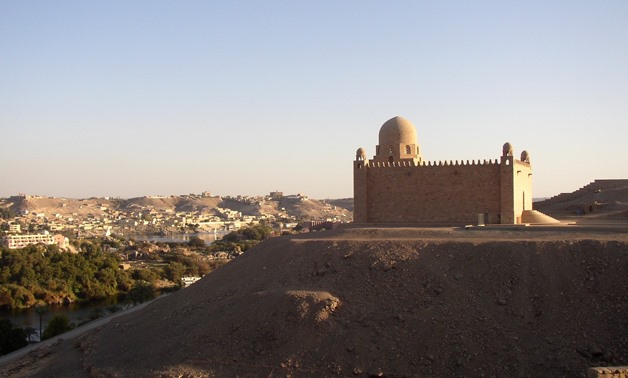
The Mausoleum of Aga Khan III in Aswan - Courtesy of Philippe LhospitalierLhospitalier
CAIRO – 15 June 2017: Aswan is renowned for the Philae Temple dedicated to Isis, the goddess of love. But there’s a princely shrine that sits on the west bank of the Nile overlooking the city’s iconic architecture that many consider one of the truest symbols of love anywhere in Egypt.
The contemporary memorial — constructed long after the country’s well-known Egyptian, Greek and Roman monuments — has become so popular that many consider it one of Egypt’s “must” destinations. The combination of a love story and architecture style prompt some to compare it to the Taj Mahal, the ivory-colored marble mausoleum on the bank of the Yamuna river in Agra, India.
Though not as large as the Taj Mahal, the pinkish limestone Mausoleum of Aga Khan has a white Carrara marble tomb and is built in the style of the Fāṭimid Dynasty, which was founded in Cairo by the Aga Khan’s ancestors in 969. The Fāṭimids are primarily remembered as patrons of the arts, architecture, literature, pluralism and scientific endeavors and are considered one of the apogees of Muslim culture.
The mausoleum is not only the burial site of the Aga Khan, who used to spend part of the winter living in a nearby villa and was buried here two years after he died in Geneva in 1957. It has also become a poignant symbol of love because a fresh red rose has been laid on the Aga Khan's tomb every day since he died.
The ritual of the rose was initiated by the Aga Khan's fourth and last wife, the French-born Yvette Labrousse who he met at in Cairo in the late 1930s.
The couple have fell in love at first sight at the chic dancing party in Cairo. Begum Om Habibeh Aga Khan — a former beauty queen and Miss France remembered for the work she did with women, the poor and elderly — was the only wife of the Aga Khan who converted to Muslim, fully supported his charitable life mission and handled arrangements after his death.
The Aga Khan playfully nicknamed Om Habibeh "Yaky" — which was composed from the initials of "Yvette", "Aga" and "Khan" — and said about his marriage to a woman almost three decades younger that "If a perfectly happy marriage be one in which there is a genuine and complete union and understanding, on the spiritual, mental and emotional planes, ours is such."
Yaky oversaw the building of the mausoleum, a task that took 16 months under the direction of architect Farid El-Shafie and contractor Hassan Dorra, almost immediately after her husband’s death. She continued to spend three months each winter at their white villa near the Mausoleum and personally delivered the rose to his tomb each morning, a ritual performed daily by her gardener in her absence. There is even a story that once when there was not a single rose found in Egypt the flower was sent from Paris by a private plane for six consecutive days.
Yaky was also buried in the mausoleum after she died in the south of France in July 2000. And today the couple continues to lay side by side and are both remembered for their mutual love story worth a movie.
Egypt was a special place for Sir Sultan Mohammed Shah Aga Khan III, the 48th Imam of the Shia Ismali Muslims and an influential Indian spiritual leader, who was the 49th imam in the Nizari Ismaili community and believed to be a descendant of the Prophet by his followers. He almost became the king of the Egypt in 1914.
“On my way home to India I visited Egypt for the first time,” the Aga Khan wrote in his memoirs about his first visit to the country in 1935. “Those who have not experienced it, who have not been lucky enough to fall under Egypt’s spell, will find it difficult, I suppose, to realize the sheer magic of the first sight of Egypt.” The Aga Khan’s first glimpse of Egypt “was on a perfect early winter day, and need I say that all my life since then I have had a special corner in my heart for Egypt, and that I have returned there as often as I could.”
The Aga Khan, who suffered from rheumatism and bone pain, had a special affinity for Aswan where, after spending many visits at the famed Cataract Hotel, he built a villa for his beloved Yaky, enjoyed the inviting warm winter climate, used medicines provided by Nubian elders and experienced the healing powers of Aswan’s sands. Advised by the Nubians, Sheikh Khan once buried his lower body in the local sands for three hours each day for a week to remedy an ailment.
It was always his wish to be buried there.
Although today the Mausoleum of Aga Khan is closed for the public, the ritual of the rose has attained a mythical status and has prompted pilgrimages to the site by young lovers throughout the world.
 The White Villa House - Courtesy of Philippe Lhospitalier - Courtesy of Philippe Lhospitalier
The White Villa House - Courtesy of Philippe Lhospitalier - Courtesy of Philippe Lhospitalier
 The Mausoleum of Aga Khan III in Aswan, a view from the garden of Isis Island Hotel - Courtesy of Philippe Lhospitalier
The Mausoleum of Aga Khan III in Aswan, a view from the garden of Isis Island Hotel - Courtesy of Philippe Lhospitalier
 The Mausoleum of Aga Khan III in Aswan - Courtesy of Philippe LhospitalierLhospitalier
The Mausoleum of Aga Khan III in Aswan - Courtesy of Philippe LhospitalierLhospitalier



Comments
Leave a Comment